
 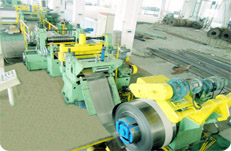 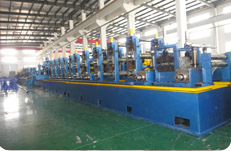 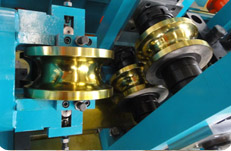  |
Introduction of the high frequency welded tube mill line
Process chart
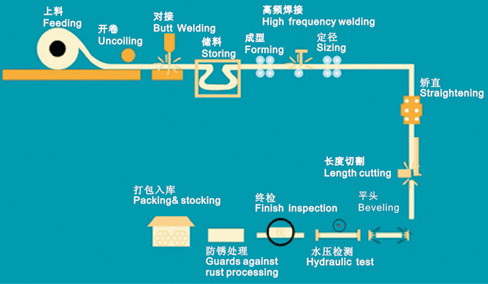
Layout of High frequency welded tube mill
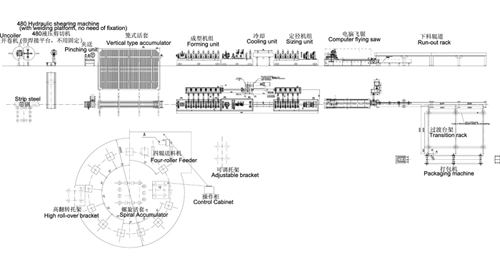
Introduction of the roll forming process
Roll forming is a continuous metal forming process, in which roll forming machines are used to shape metal coils or sheets into parts as the material moves through the machine. Roll forming machines consist of sequences of roller die pairs, located on both the top and bottom of the machine. As the metal moves through the machine, the rollers bend the material along the linear axis, forming a variety of different configurations. Typically, roll formed parts are created at room temperature, making this a cold forming process. Roll forming is able to accommodate a wide selection of metals, including bronze, brass,zinc,titanium,copper, aluminum and steel. Of these metals, however,aluminum and steel remain the most commonly used.
Some of the parts that manufacturers use roll forming to create include channels, angles and rings. These parts are the foundations for many industrial products, providing support and connection for a variety of applications. Channeals provide a support system for numerous roll-formed products, such as frames and rails. Angles provide support in two directions, and they are used on corners and edges. Angles also contain holes for connecting parts. Finally, rings are commonly rolled from other shapes and often function as container seals and lids. In addition to standard configurations, many manufacturers will offer custom roll forming services to fulfill customer requests.
Roll forming services can quickly and efficiently accommodate high-volume orders. Roll forming machines are able to maintain production speeds ranging from 100 to 180 feet per minute. Most roll forming services use approximately 94% of the coil material during the forming operation, resulting in fewer leftover scraps than other processes. The range of shapes that roll forming can create is diverse, and the final products have more consistency and tighter dimensional control. On the downside, however, the production of extremely short parts may not be feasible for everyone, since to cover the tooling costs, 100,000 feet per year must be produced and sold. Roll forming is, therefore, best for high volume productions.
A variety of industries utilize roll forming services. For the aerospace industry, roll formed products are used for window frames, helicopter blades and trimming . The appliance industry uses these products for handles, drawer slides, refrigerator shelves, ladder supports and control panels. Fence posts and lawn and garden equipment for agriculture are other examples of the many diverse products created from the roll forming process. Further uses are products for vending machines, conveyor systems, gas station pumps, ramps, rail cars, craneways, racks and shelving, guardrails and doorframes.
Process chart

Layout of High frequency welded tube mill

Introduction of the roll forming process
Roll forming is a continuous metal forming process, in which roll forming machines are used to shape metal coils or sheets into parts as the material moves through the machine. Roll forming machines consist of sequences of roller die pairs, located on both the top and bottom of the machine. As the metal moves through the machine, the rollers bend the material along the linear axis, forming a variety of different configurations. Typically, roll formed parts are created at room temperature, making this a cold forming process. Roll forming is able to accommodate a wide selection of metals, including bronze, brass,zinc,titanium,copper, aluminum and steel. Of these metals, however,aluminum and steel remain the most commonly used.
Some of the parts that manufacturers use roll forming to create include channels, angles and rings. These parts are the foundations for many industrial products, providing support and connection for a variety of applications. Channeals provide a support system for numerous roll-formed products, such as frames and rails. Angles provide support in two directions, and they are used on corners and edges. Angles also contain holes for connecting parts. Finally, rings are commonly rolled from other shapes and often function as container seals and lids. In addition to standard configurations, many manufacturers will offer custom roll forming services to fulfill customer requests.
Roll forming services can quickly and efficiently accommodate high-volume orders. Roll forming machines are able to maintain production speeds ranging from 100 to 180 feet per minute. Most roll forming services use approximately 94% of the coil material during the forming operation, resulting in fewer leftover scraps than other processes. The range of shapes that roll forming can create is diverse, and the final products have more consistency and tighter dimensional control. On the downside, however, the production of extremely short parts may not be feasible for everyone, since to cover the tooling costs, 100,000 feet per year must be produced and sold. Roll forming is, therefore, best for high volume productions.
A variety of industries utilize roll forming services. For the aerospace industry, roll formed products are used for window frames, helicopter blades and trimming . The appliance industry uses these products for handles, drawer slides, refrigerator shelves, ladder supports and control panels. Fence posts and lawn and garden equipment for agriculture are other examples of the many diverse products created from the roll forming process. Further uses are products for vending machines, conveyor systems, gas station pumps, ramps, rail cars, craneways, racks and shelving, guardrails and doorframes.